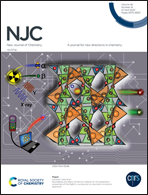In silico studies revealed interaction mechanisms of benzylidene–acrylohydrazide derivatives and nsP2 CHIKV†
Abstract
The Chikungunya virus (CHIKV, Togaviridae family, Alphavirus genus) represents an emerging public health problem worldwide because it causes high morbidity and mortality rates. NIAID (USA) classified CHIKV as a priority group in category C. CHIKV fever (CHIKF) is defined by the WHO as a neglected tropical disease and is characterized by an intense and disabling polyarthralgia. To date there is no treatment for CHIKV infection and the search for anti-CHIKV drugs is needed. Nonstructural protein 2 (nsP2) is a therapeutic target due to its essential protease activity on viral replication. Thus, several compounds have been studied in the search for CHIKV nsP2 inhibitors. Giancotti et al., Rational modifications on a benzylidene-acrylohydrazide antiviral scaffold, synthesis and evaluation of bioactivity against Chikungunya virus, Eur. J. Med. Chem., 2018, 149, 56–68, DOI: 10.1016/j.ejmech.2018.02.054 synthesized a series of benzylidene–acrylohydrazide derivatives that showed anti-CHIKV activity (EC50) against nsP2. Analyzing their pharmacokinetic and toxicological (ADMET) properties we note that these derivatives followed Lipinski's rule; they were able to penetrate the CNS and were not hepatotoxic. In order to understand the ligand binding conformation of the anti-CHIKV compound, we docked these compounds against nsP2 (PDB ID: 3TRK), using distinct scoring functions in order to verify which one had the best correlation with biological activity. The results showed that GOLD 5.5 (PLP) ranks 50% of the most active compounds (5.59 < pEC50 < 4.53) among the best energies, followed by AutoDock 4.2 (43%), Vina (29%) and the GOLD-5.7.3 (ChemScore) (21.5%). However, AutoDock 4.2 had a lower false positive rate (8%) compared to the PLP function (28%), which led us to choose AutoDock 4.2 to analyze their interaction mode. Analyzing these interactions with nsP2, compound 51 obtained the best energy (−8.75 kcal mol−1) due to its hydrogen bond interactions with the residues ALA-1010, ASN-1011, ALA-1046 and ASN-1082, which were related to aiding the binding of the nsP2 substrate. Our results will help in the development of more potent inhibitors against CHIKV nsP2 based on the understanding of the interaction patterns of benzylidene–acrylohydrazide derivatives.



 Please wait while we load your content...
Please wait while we load your content...